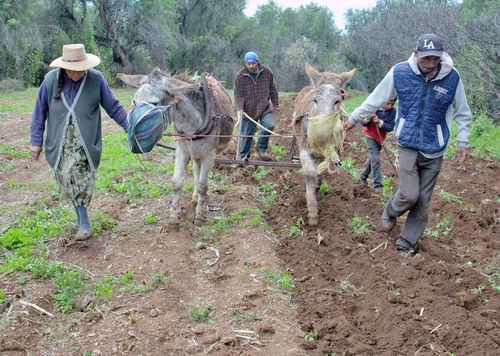▲ Guarantee prices and Production for well-being are government programs to promote food self-sufficiency. In the graph, peasants from Zacatecas.Photo Alfredo Valadez.
Angelica Enciso L.
Newspaper La Jornada
Monday, May 9, 2022, p. 4
The high imports of fertilizers to supply two thirds of the national demand and whose price has increased by more than one hundred percent since 2021, has led farmers to use fewer doses, to the detriment of crops or to stop planting, which will impact food production.
Only 2 million tons of the input are manufactured in the country, given a demand of 6.5 million, even the federal government imports it to cover part of the support for the fertilizer program.
The relevance is such that of 22 million hectares cultivated in the national territory, fertilizers are used in 15 million, according to reports from the Agricultural and Fisheries Information System (SIAP), and this input represents 30 percent of production costs. Mexico is the sixth largest buyer of nitrogenous fertilizers in the world and the seventh of urea, indicate 2020 United Nations studies.
The price may be the least of the problems
Even so, the high cost of fertilizers could be the least of the problems, given the risk that there will be shortages in the immediate future and negatively impact crops, said Marcel Morales, an expert on agricultural issues and director of the 21st Century Biofactory.
Russia, currently in a war with Ukraine, is one of the main producers of fertilizer and has made the decision to reduce sales.
He estimated that, with the high costs of crop improvement chemicals, there would be a collapse in the production of corn and beans, since they planted less land or used lower doses, which will mean lower yields.
The scarcity of fertilizers dates back two decades, when a ton of urea, the most widely used, went from 1,900 pesos to 8,000 in 2019, and now reaches up to 24,000 pesos, he said. In 2021, prices grew by more than one hundred percent, indicates information from the Agricultural Markets Consulting Group.
To this is added the increase that occurred at the beginning of the war in Russia and Ukraine: in the first quarter of the year, urea had an increase of 72.4 percent compared to the same period in 2021, he indicated.
The rise in fertilizer prices is affected by the increase in goods for its production, since data from the World Bank indicate that in 2021 natural gas rose 91 percent and oil 67 percent. Added to this are the interruptions in freight transport flows due to the covid-19 pandemic, which has contributed to farmers reporting higher prices at least every 15 days, since last October.
The country is highly dependent on imports. Last year they amounted to 4.4 million tons, which is equivalent to 65 percent of the total national consumption.
Of those foreign purchases, 30 percent come from Russia. While in the country only 2 million tons were produced in 2021, 500 thousand less than in 2019, data from the SIAP indicate, which indicates that the decrease in this production began in 2013, when 2 million 82 thousand tons were generated.
Meanwhile, Sader distributed 185,000 tons in the fertilizer program last year, of which 55 percent imported and announced since April that the operation will be expanded to corn farmers from indigenous communities in nine states.
In 1991 the privatization of the Fertimex units began and by 1993, the 12 plants distributed in the central, gulf and northeast regions of the national territory were already private, it is estimated that they had an installed capacity to produce 4.5 million tons.








